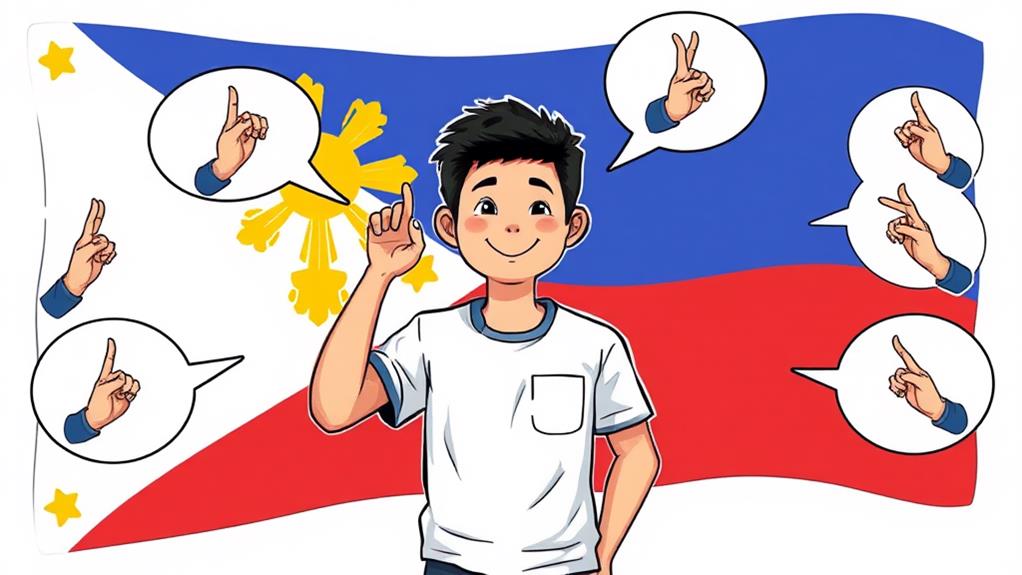Incorporate Respectful Language
When interacting with Filipinos, it's essential to use respectful language to show politeness and courtesy. Add "po" or "opo" to your greetings and responses to convey respect. For example, instead of saying "Kumusta?" (how are you?), say "Kumusta po?" to show respect.
Use Time-Specific Phrases
Using time-specific phrases can add a personal touch to your greetings. Say "Magandang umaga" (good morning), "Magandang tanghali" (good noon), or "Magandang gabi" (good evening) to greet someone at the appropriate time of day.
Show Politeness with Key Phrases
Showing politeness is crucial when interacting with Filipinos. Use "Salamat po" (thank you) to express gratitude. Additionally, add "Paki" before requests, such as "Paki-bigay ng tubig" (can you give me water?).
Formal and Elder Interactions
When interacting with elders or in formal settings, it's essential to show even more respect. Use "Kumusta kayo?" (how are you, plural) instead of "Kumusta?", and perform the traditional gesture of hand-kissing, known as "Mano po".
Mastering Kumusta and Beyond

Mastering Tagalog greetings is crucial for everyday interactions in the Philippines. "Kumusta?" is the primary Tagalog greeting, equivalent to "How are you?", derived from the Spanish "¿Cómo estás?" due to historical Spanish influence on Filipino culture.
To show respect, use "Kumusta kayo?", the plural and formal variation, especially when addressing elders or in formal situations. Incorporate "po" or "opo" in your greetings and responses to convey respeto, a deeply rooted value in Filipino culture.
Time-specific greetings like "Magandang umaga" (good morning) or "Magandang hapon" (good afternoon) can add authenticity to your interactions.
Using the right Filipino words and phrases helps build stronger connections with locals. By mastering "Kumusta?" and its variations, you'll be well on your way to language learning success in the Philippines.
Essential Polite Expressions
Polite Expressions Matter in Tagalog Culture
When interacting with Filipinos, using polite expressions is crucial in everyday conversations. In Tagalog culture, the right phrases can significantly impact how you're perceived and received. This is especially important when speaking to elders, as addressing them with respect is deeply ingrained in Filipino cultural nuances.
Essential Phrases to Show Respect and Gratitude
Po/Opo is a polite particle used when addressing someone older. Salamat po means "Thank you," and Walang anuman means "You're welcome." These phrases help show gratitude and respect in various situations.
Adding Politeness to Requests
Using "Paki" before a request, such as "Pakiusap," adds a layer of politeness equivalent to saying "please" in English.
Apologizing with Courtesy
If you need to apologize, "Pasensya na" (Sorry or Excuse me) is a crucial phrase to maintain courteous communication.
Greetings for Every Situation

In the Filipino culture, greetings are essential for building connections and fostering relationships. Mastering various greetings for different situations helps establish stronger bonds with Filipinos.
Kumusta? (How are you?) is a commonly used greeting suitable for both casual and formal contexts. This versatile greeting can be used with friends, family, or even strangers.
In more formal situations, Mabuhay (Live) conveys respect and celebration, making it suitable for ceremonies and events. For example, you can use Mabuhay when attending a traditional Filipino wedding or during cultural festivals.
Mano po is a traditional gesture involving hand-kissing to show respect, typically used when greeting parents, grandparents, and community elders. This gesture is a sign of reverence and is often used during special occasions.
When greeting someone with respect or addressing a group, Kumusta kayo? (How are you, formal or plural?) is the formal or plural version of "Kumusta?" This greeting is used to show deference to the person or group being addressed.
Responding With Culture in Mind
Responding to greetings in the Filipino culture requires cultural sensitivity and respect. When interacting with Filipinos, using their language demonstrates that you value their customs and traditions.
In Tagalog, using polite forms like "po" and "opo" enhances the formality of interactions, especially when addressing elders.
When someone asks "Kumusta?" (how are you?), you can respond with "Mabuti, ikaw?" (I'm fine, and you?) to encourage mutual engagement and maintain social etiquette.
The traditional gesture "Mano po," which involves hand-kissing, is a way to show respect when greeting elders. Understanding and using variations of greetings, such as "Kumusta kayo?" for formal or plural contexts, showcases respect and appreciation for Filipino cultural norms.
In Filipino culture, respect and politeness are deeply rooted. To build connections and foster deeper relationships, use the right words and phrases to demonstrate your consideration.
How Can Key Tagalog Words Enhance Polite Greetings and Phrases?
Incorporating key tagalog words for daily conversations into greetings and phrases adds a layer of cultural respect and warmth. Words like “po” and “opo” signify politeness, while “kumusta” fosters connection. These expressions demonstrate effort and appreciation for Filipino customs, enriching exchanges and creating a positive impression in any interaction.
Elevating Your Interactions

Elevate your interactions with Filipinos by incorporating culturally sensitive phrases that demonstrate your appreciation for their customs. This effort will help build stronger relationships, as Filipinos value understanding and respect for their culture.
Show respect with "po" or "opo": When responding to greetings, add "po" or "opo" to demonstrate respect, especially when interacting with elders or authority figures. This polite phrase is a significant aspect of Filipino culture and will be appreciated by those you interact with.
Use "Mabuhay" for formal occasions: The Tagalog word "Mabuhay" literally means "long life," but it conveys respect and celebration, making it suitable for formal occasions such as weddings, graduations, or business events.
Respond with "Mabuti, ikaw?": Next time, try responding to greetings with "Mabuti, ikaw?" (I'm fine, and you?) to encourage mutual engagement and reflect the value placed on social interaction in Filipino culture.
Incorporate polite phrases like "Maraming Salamat" and "Walang anuman": Enrich your conversations and build rapport by using these common polite phrases.
"Maraming Salamat" means "thank you very much," while "Walang anuman" means "you're welcome." Using these phrases will show your appreciation for Filipino culture and help you build stronger relationships.
Frequently Asked Questions
What Is a Respectful Greeting in Tagalog?
In Tagalog, a respectful greeting is culturally significant.
A classic greeting is "Kumusta?", which means "How are you?" and has a rich history, derived from Spanish.
In formal situations, such as ceremonies, "Mabuhay" (meaning "live") is used to convey respect and celebration.
To show deference, especially to elders, it's essential to add "po" or "opo" to your greeting.
How Do You Greet Someone in Tagalog?
Greeting Someone in Tagalog: A Guide
When greeting someone in Tagalog, "Kumusta?" (How are you?) is a common and essential phrase to know.
For formal occasions, use "Mabuhay" (Live) or "Kumusta kayo?" (How are you, all?).
In casual settings, regional variations exist, but "Kumusta" is a universally accepted greeting.
Time-specific greetings are also used, such as "Magandang umaga" (Good morning) and "Magandang gabi" (Good evening).
When greeting friends and family, "Kumusta" or "Musta" (How are you, informal) are suitable options.
Remember to respond with an inquiry about the other person's well-being to show respect.
How to Be Polite in Filipino?
Showing Respect in Filipino Culture
When interacting with Filipinos, it's essential to be mindful of cultural nuances to show respect.
In formal settings, use formal titles and polite phrases like "Maraming Salamat po" to show gratitude. This phrase, which means "thank you very much," is a polite way to express appreciation.
Addressing Elders with Respect
In family interactions, address elders with "Kuya" or "Ate", which mean "older brother" or "older sister," respectively. This is a sign of respect for age differences.
Use gestures like "mano po", where you take the elder's hand and place it on your forehead, to demonstrate respect.
Regional Variations and Body Language
Be aware of regional variations and body language, as a slight bow or gentle handshake can go a long way in showing social etiquette. This can help you build meaningful relationships and earn respect in Filipino culture.
How to Show Respect in Filipino?
Demonstrating Respect in Filipino Culture
In the Filipino culture, showing respect isn't just about being polite, it's about honoring cultural traditions and values. When interacting with family members, use titles like "Kuya" or "Ate" to address older siblings, as a sign of respect and affection.
When addressing elders, use formal language to show deference.
Traditional Customs and Values
In Filipino culture, traditional customs like "mano po" (a gesture of respect where the younger person takes the elder's hand and places it on their forehead) and acknowledging age hierarchy are essential.
These customs demonstrate that you value community values and respect the wisdom and experience of elders.
Language and Etiquette
Use formal address when necessary, especially when interacting with people you don't know well or when in formal settings.
This shows that you respect the other person and are willing to adapt to local etiquette. By doing so, you'll earn respect and build stronger relationships.